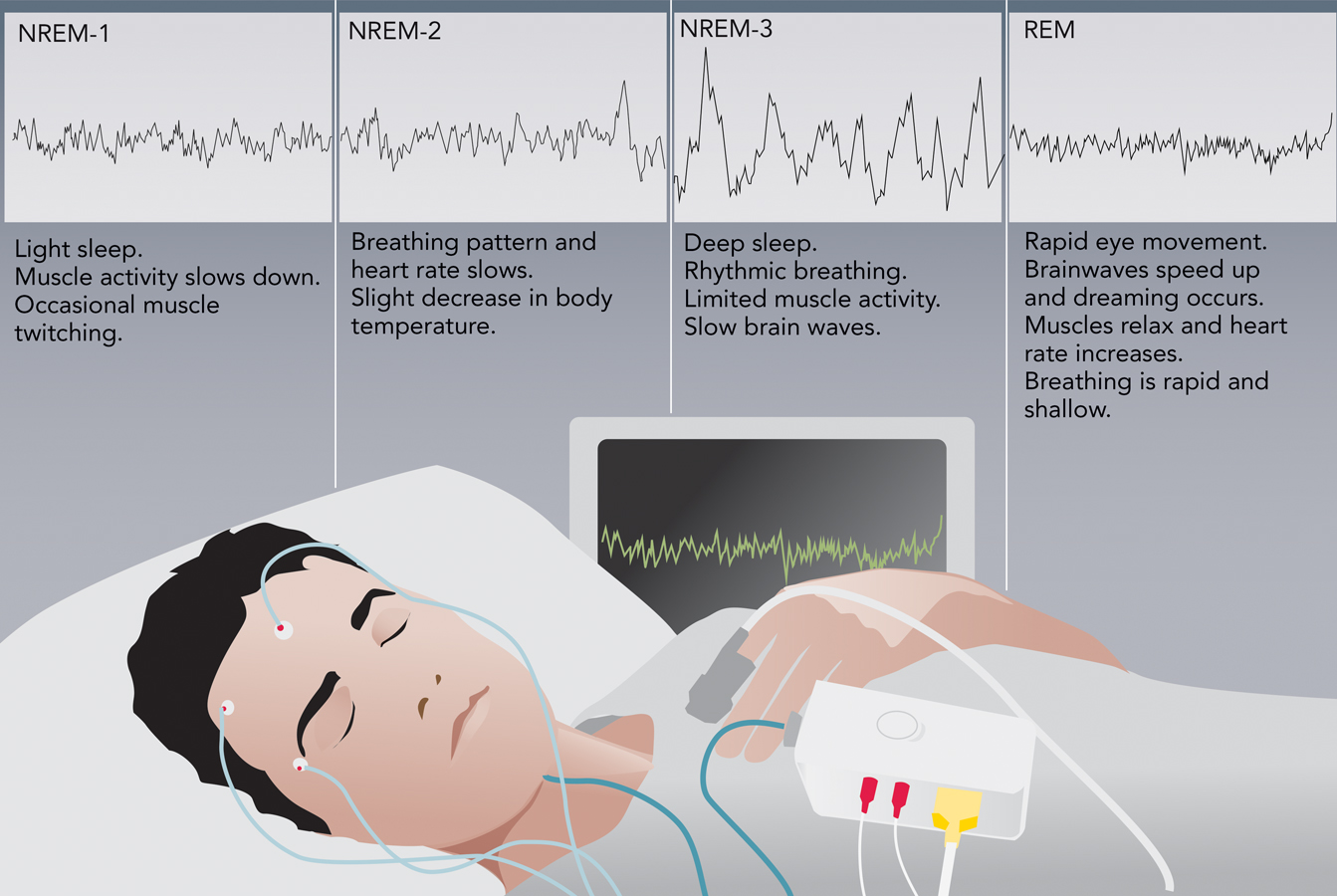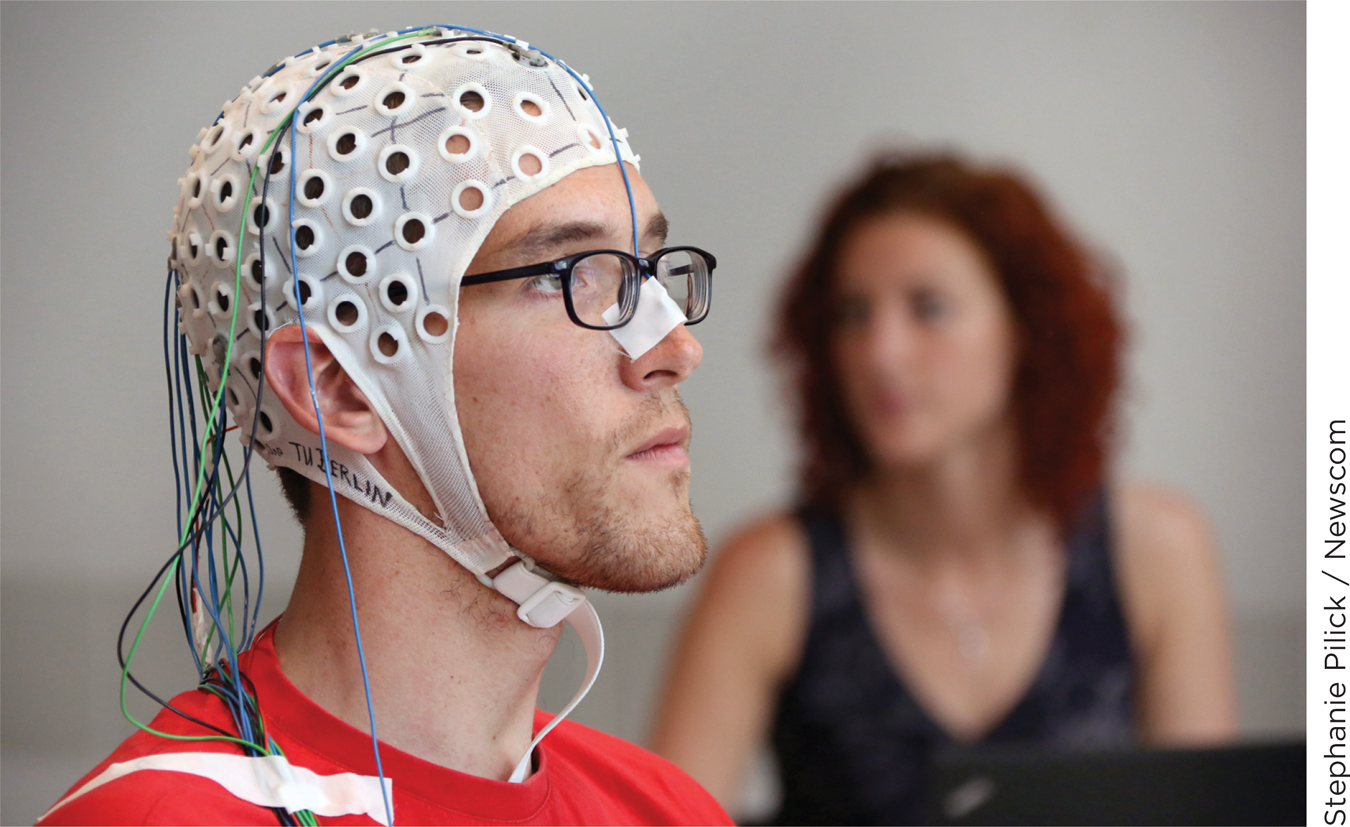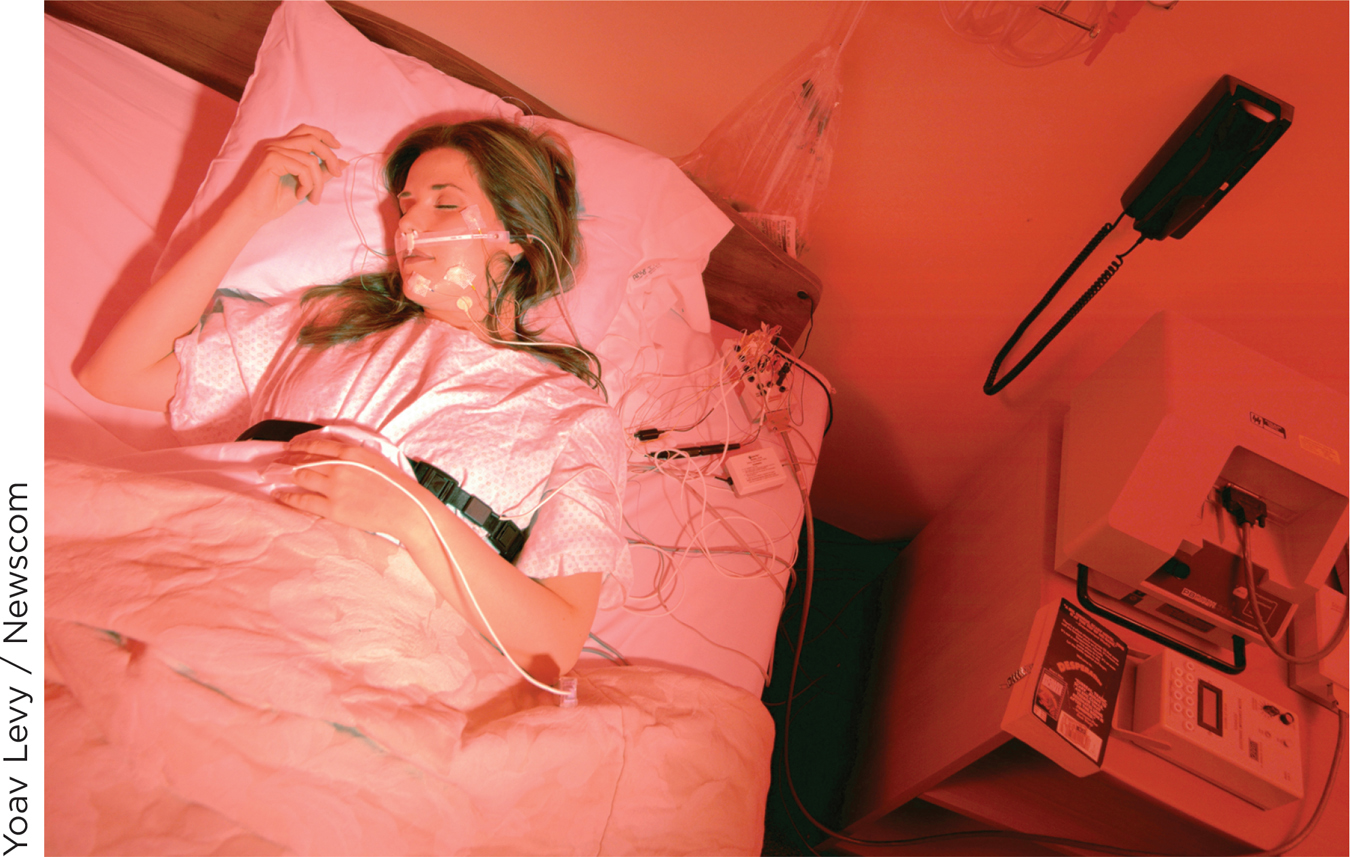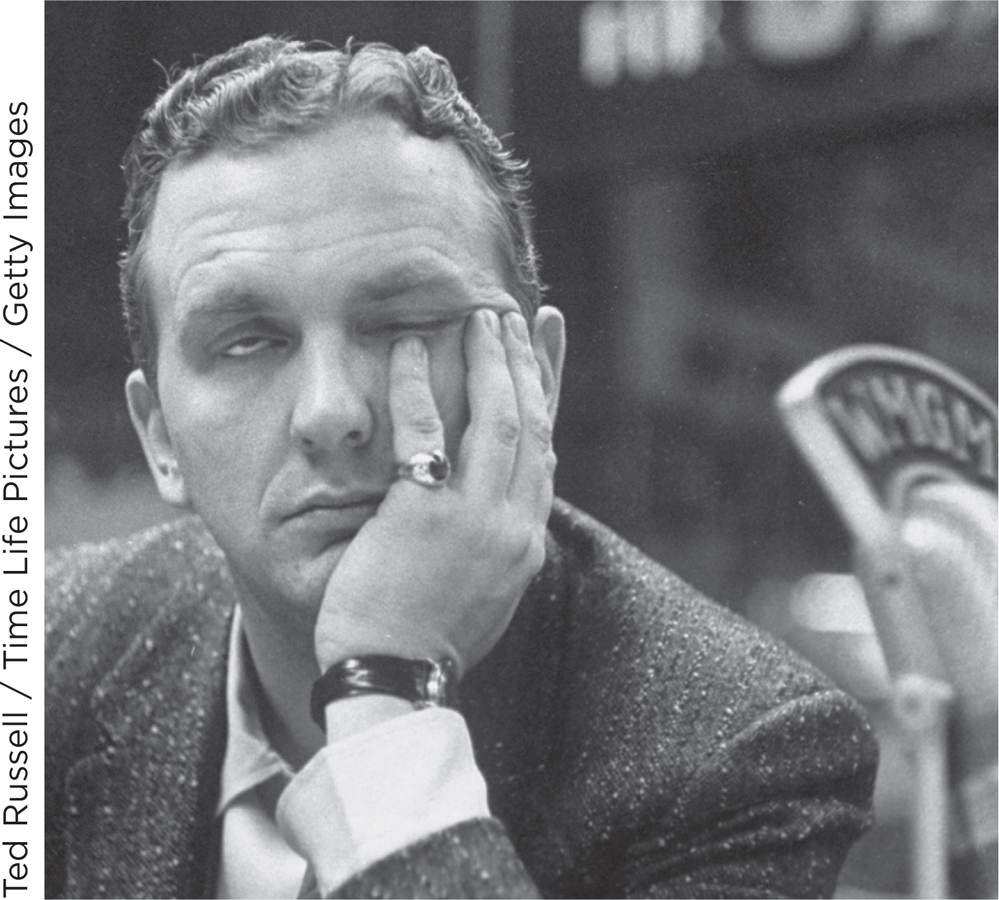9.5 Sleep
Thus far in this chapter, you have learned about how you consciously experience the sights and sounds of the external world. Yet, during about a third of your life, you don’t experience them. About a third of the time, if someone held a picture in front of your face, tapped you gently on the arm, or whispered in your ear, you wouldn’t even notice. These are the times when you are asleep.
The Varieties of Sleep
Preview Questions
Question
 What characterizes REM and non-
What characterizes REM and non-
Question
 Why, during REM sleep, do our eyes move rapidly but our muscles stay relatively still?
Why, during REM sleep, do our eyes move rapidly but our muscles stay relatively still?
Question
 What characterizes sleep stages?
What characterizes sleep stages?
The word “sleep” seems to refer to a single state. You may believe that when you fall asleep at night, your mind and body enter a resting state—
TWO TYPES OF SLEEP. Sleep is not a single state. You alternate between two different types of sleep, usually about every 90 minutes, throughout the night (Siegel, 2003). One is called REM (rapid eye movement) sleep because, during this sleep phase, your eyes move rapidly back and forth. The other state is non-
Bodily states during REM and non-
REM sleep: Heart rate, blood pressure, and breathing rate vary during REM sleep, just as they do during waking periods. Both men and women experience genital arousal (even if not having sexual dreams).
Non-
REM sleep: Heart rate and blood pressure are lower than during wakefulness and are very consistent throughout the non-REM period. Body temperature is lower than wakefulness, and breathing slows.
Brain functioning also differs in REM versus non-
Brain-

People dream during both REM and non-
What is the function of REM sleep’s rapid eye movements? Brain-
With all the brain activity that occurs during REM sleep, you might wonder how you manage to stay asleep. As you learned, the motor cortex is active during REM sleep. Why, then, aren’t you running around your bedroom while you are having a dream about running, or shouting out loud whenever you are shouting in your dreams?
During REM sleep, your body remains still because your brain “switches off” the body’s main system for moving your muscles. It does this by altering brain chemistry. The brain changes the release of neurotransmitters that, during waking periods, activate cells that control motor movement (Siegel, 2003). As a result, during REM sleep, you are largely paralyzed; the muscles in your arms and legs do not move at all. (Other muscles, such as those that control the heart and eyes, function normally.) Sometimes this paralysis lasts for a brief period after people wake up, and they experience a potentially frightening state known as sleep paralysis, in which a person is awake but temporarily unable to move or talk (Hishikawa & Shimizu, 1995).
Evidence of how the brain switches off muscle movements during dreams comes from a study in which researchers disabled the brain’s switching-
What would your life be like if, during REM sleep, you were not paralyzed?
SLEEP STAGES. When during the night do these periods of non-
During the first 90 minutes after you fall asleep, you experience a series of three non-

Biochemical and neural processes are responsible for the transitions from non-
Small sets of cells in lower regions of the brain control this sleep cycle. A group of neurons in the base of the forebrain known as “sleep-
RESEARCH TOOLKIT
EEG
People have been interested in the mysteries of sleep and dreams for thousands of years. Yet the most basic facts—
The brain produces electrical activity whenever an action potential travels down the length of a neuron (see Chapter 3). Because there are billions and billions of neurons, a lot of electrical activity occurs—
The electrodes detect brain waves, which are cyclical patterns of activity in any given brain region. In other words, in any area of the brain, there are wave-
In EEG research, participants wear electrodes that are placed on specific regions of the scalp (and may be held in place there by a cap; see photo). The electrodes detect waves of activity in the area of the brain directly underneath them. The resulting brain wave recordings are then plotted on a graph.
Conveniently for sleep researchers, EEG recordings can be taken while a person is sleeping. The electrodes are not uncomfortable, so participants can doze off while wearing them.
Researchers began to use EEG to study sleep in the mid-
Like many good tools, EEG can be used for more than one purpose. In addition to sleep, researchers use EEG to study topics such as emotion, motivation, and individual differences in children’s temperament. Researchers throughout psychology have “caught the EEG wave.”
WHAT DO YOU KNOW?…
Question 15
True or False?
EEG is the abbreviation for electrocardiogram.
A. B. According to EEG readings, brain waves are greater in amplitude during REM sleep than they are during non-
REM sleep. A. B.

WHAT DO YOU KNOW?…
Question 16
Identify whether the items below characterize REM sleep or non-
Muscles are largely paralyzed.
A. B. Heart rate and blood pressure are consistent.
A. B. Body temperature is lower than during wakefulness.
A. B. Consists of three stages that are each progressively deeper.
A. B. Brain activity is similar to that of wakefulness.
A. B. Dreams are frequent and typically more vivid.
A. B. Heart rate and blood pressure are lower than during wakefulness.
A. B. Genital arousal occurs.
A. B.
Studying Sleep
Preview Question
Question
 How have sleep labs been used to study the timing of the body’s internal clock?
How have sleep labs been used to study the timing of the body’s internal clock?
Studying sleep scientifically is challenging. Scientists need to observe normal 8-
SLEEP LABS. Researchers meet this challenge by conducting research in sleep labs. A sleep laboratory is a scientific facility for studying sleep that includes a hotel-
Sleep labs have two big advantages for research. First, researchers can monitor research participants’ heart rates, brain waves, eye movements, and other aspects of physiology while they are sleeping. Second, they can control environmental factors that would be impossible to control in the home environment. This control enables experimental tests of competing theoretical explanations of sleep, waking, and internal biological states. Here’s an example.
MANIPULATING LENGTH OF DAY. People (and other mammals) experience a circadian rhythm, an approximately 24-
How could one find out which factor—

Researchers have created this alternative world in sleep labs. In one study (Czeisler et al., 1999), participants lived in a sleep lab for a month. They had no access to watches or clocks. Unbeknownst to the participants, the researchers created different light–
Remarkably, the shifts in environmental cues had no effect on bodily rhythms. The circadian rhythms of people experiencing 20-
How likely would you be to volunteer for a month-
WHAT DO YOU KNOW?…
Question 17
By manipulating light–
THINK ABOUT IT
The research participants in sleep lab studies tend to be healthy individuals who live in wealthy nations and thus do not experience severe conditions of life (malnourishment, untreated medical conditions, etc.). How do we know that their sleep patterns are similar to those of people who face more difficult living conditions?
Sleep Theories
Preview Question
Question
 Why do we sleep?
Why do we sleep?
It’s possible to imagine a world in which animals did not sleep. They might rest, to save energy, yet not lapse into the states of unawareness that comprise sleep. From the perspective of any individual organism, this sleep-
Yet, in the real world, all mammals sleep. In fact, all known mammals experience both non-
Identifying this advantage is difficult. Scientists have not reached complete agreement on the primary benefits of sleep. They have, however, identified some possibilities.
Non-
An alternative possibility is that sleep is needed not to repair the body as a whole, but to repair only one bodily organ in particular: the brain. When animals are awake, their bodies produce biochemical waste products that can build up in the brain and harm its functioning. Changes that occur within the brain when animals sleep make it easier for the brain to remove these waste products (Xie et al., 2013).
Other biological needs may contribute to sleep patterns. One possibility is food needs. Herbivores (animals that eat plants but not meat) need more time to forage for food than do carnivores (meat eaters). They also tend to get less REM and non-
In summary, it is difficult to know exactly why animals need to sleep. But there is no question that they do need their daily shut-
WHAT DO YOU KNOW?…
Question 18
Which of the following statements about sleep are accurate?
The lower metabolic rate of non-
REM sleep may be necessary for the brain to repair itself. A. B. Herbivores, who require more time to forage for food, have less time available for sleep.
A. B. Non-
REM sleep, which is more abundant early in life than in adulthood, helps to establish neural connections. A. B.
Sleep Disturbed
Preview Questions
Question
 In what ways does sleep deprivation impair performance?
In what ways does sleep deprivation impair performance?
Question
 What characterizes sleep disorders?
What characterizes sleep disorders?
In 1959 a radio announcer named Peter Tripp staged a “wakeathon.” While being observed by medical personnel, Tripp stayed awake for a record 201 consecutive hours. The record didn’t last for long. In 1964, a high school student named Randy Gardner broke it by staying awake for 264 hours—
SLEEP DEPRIVATION. What’s it like to go for days without sleep, or to experience extreme sleep deprivation? Being sleep deprived does more than just make you tired. It impairs your normal conscious experiences. After about 4 days, both Tripp and Gardner started hallucinating. Tripp thought some spots on a table were insects. Gardner thought a street sign was a person. Soon after that, Gardner, who was white, had a delusional experience in which he thought he was a prominent black athlete (Coren, 1998).
Research in which participants are kept awake for extended periods confirms that sleep deprivation disrupts thinking. When 25 volunteers from the U.S. military were kept awake for 56 hours (Kahn-


There’s a lesson here. If you’ve got an exam coming up, be sure to get plenty of sleep! Inadequate sleep is “the performance killer” (Czeisler & Fryer, 2006). It reduces your alertness and ability to concentrate and solve problems. Even if sleep is merely reduced (e.g., to 5–
Inadequate sleep impairs performance not only on complex mental activities, such as taking a test, but also on simpler tasks that require sustained attention and quick reactions, such as driving. In the United States, drowsy drivers cause 20% of all automobile accidents (Czeisler & Fryer, 2006). One-
Think of a time when you were sleep deprived. Were the effects similar to those described here?
SLEEP DISORDERS. In the cases of sleep deprivation we just discussed, people who were medically healthy got inadequate amounts of sleep. This lessened sleep resulted from personal choices or social pressures, such as a busy work schedule. A second type of sleep disturbance is different; it results from a medical condition. A sleep disorder is any medical condition that disrupts normal patterns of sleep. A person suffering from a sleep disorder may have difficulty falling asleep or staying asleep, or may suddenly fall asleep at times when they need to stay awake. Let’s look at four main kinds of sleep disorder (American Sleep Apnea Association, 2013; National Heart, Lung, and Blood Institute [NHLBI], n.d.).
Narcolepsy is a relatively rare disorder in which people experience sudden, extreme feelings of sleepiness during the day. Even if they have gotten 8 hours of sleep the night before, people with narcolepsy experience exhaustion, low energy, and mental “cloudiness” during the day. They have trouble staying alert in situations where they are not physically active (such as a classroom lecture). The recurring bouts of sleepiness can significantly interfere with their ability to function normally in school or at work.
Some people with narcolepsy not only feel exhausted, but also fall asleep suddenly and without control. These uncontrollable bouts of sleep tend to be brief “microsleeps” that may last only for a very brief period (Brooks & Kushida, 2002). They nonetheless can be dangerous if people are engaged in an activity such as driving when overcome by sleep.
Narcolepsy is caused by an abnormality in levels of a chemical in the brain that influences wakefulness. Unfortunately, the exact cause of this abnormality is not known and no sure-
Sleep apnea is a disorder in which people suffer from brief pauses in breathing while they are asleep. (The word apnea comes from a Greek word meaning “without breathing.”) Although there are different kinds of sleep apnea, in the most common variety the underlying cause is blockage of airways needed for breathing, especially the passageway at the rear of the throat. When people’s breathing is interrupted, their brain briefly awakens them so that they can breathe normally. These awakenings are necessary to sustain life, yet costly when it comes to a good night’s sleep.
Sleep apnea can have a variety of negative effects. Because their sleep is disturbed, people suffering from sleep apnea may experience the impaired ability to think that characterizes anyone who is sleep deprived, as discussed above. In addition, they are at risk for serious health problems such as heart failure. Sleep apnea disrupts the body’s ability to maintain normal levels of oxygen in the bloodstream. This, in turn, can cause cardiovascular problems that lead to heart failure (Javaheri et al., 1998). Some evidence links the occurrence of sleep apnea to obesity and indicates that weight loss can reduce sleep apnea symptoms (Romero-
The third sleep disorder is insomnia, which is prolonged difficulty in falling asleep or staying asleep when you have an opportunity to sleep (with that difficulty not caused by one of the other three sleep disorders described above). Everyone has trouble falling asleep on occasion. But some people experience such difficulty night after night, for two weeks in a row or more. These are people suffering from insomnia, a disorder that affects about 10% of the population (Neubauer, 2004).
There are two types of insomnia. In one, disturbed sleep is a side effect of other medical conditions or medications taken to treat them. In the other, insomnia results directly from biological or psychological factors (e.g., stressful daily events). Some foods and drinks, such as caffeine consumed close to bedtime, also can make falling asleep difficult. Alcohol can make falling asleep easier, but causes sleep to be “lighter”; that is, it raises the chance of waking up during the night rather than getting a sound eight hours of sleep. Bedtime environments that are too warm or too noisy can also make sleep harder to achieve (Ohayon & Zulley, 2001).
One treatment for insomnia is sleeping pills, obtained either by prescription or over the counter. They can reduce the time it takes to fall asleep (Dzierzewski et al., 2010; Lemmer, 2007), but have significant drawbacks, including the fact that they can be addictive. Psychological therapies are a second treatment option. In sleep therapies, psychologists educate people about factors that interfere with sleep and teach them techniques that promote a state of relaxation before bedtime (Dzierzewski et al., 2010).


Everybody wants a good night’s sleep, and everybody, at least on occasion, has trouble getting it. Let’s conclude this section on sleep with some sleep tips from the U.S. National Institute on Health (NIH, 2011). If you want a good night’s sleep:
Establish a schedule, and stick to it. It’s helpful to go to bed, and get up, at about the same time every day.
Don’t exercise late in the day. Exercise is a great thing, but it can interfere with sleep if you exercise within a couple hours of bedtime.
Avoid caffeine, nicotine, alcohol, and large meals late at night. Caffeine and nicotine are stimulants that can interfere with sleep. Alcohol makes sleep lighter, and large meals late at night can cause indigestion, which interferes with sleeping.
Relax before bedtime. A relaxing activity, such as reading, can make it easier to fall asleep.
Create a good sleeping environment. A TV or computer at your bedside can be a distraction that interferes with sleep. Try to establish a quiet sleeping area free from bright lights, noises, and electronic media.
How many of these tips do you follow? Which could you follow more closely?
WHAT DO YOU KNOW?…
Question 19
Even mild sleep (e.g., less than 6 hours a night for a couple of weeks) can impair memory and the ability to pay attention. This loss of the ability to pay attention can have dire consequences; in the United States, drowsy drivers account for % of automobile accidents. Many individuals suffering from experience “microsleeps.” The most common cause of is blockage of airways needed for breathing. Though many people experience bouts of sleeplessness, only 10% of the population experiences them to the extent that those suffering from do.
